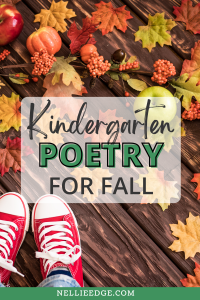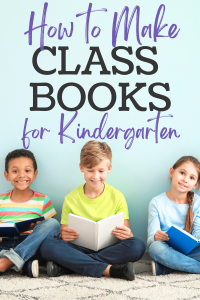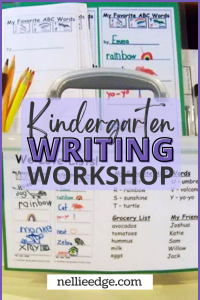A Follow-up to Kindergarten Handwriting Matters!

We are delighted with the response to our first article: “Kindergarten-Friendly Handwriting Matters!” on our new monthly kindergarten blog Joyful Pathways to Accelerated Literacy! This is a follow-up FAQ in response to many emails and questions.
1. What is the font that you use for adding fingerspelling under a child’s name? We use the inexpensive fingerspelling font from educationalfontware.com You can download the font by going to that web address, click on “Buy new academic single user license,” then scroll down to what they call the “Nellie Edge Special” (we do not receive a commission!) Click “Buy” and it will let you buy (through Paypal), download, and install the font for $5.
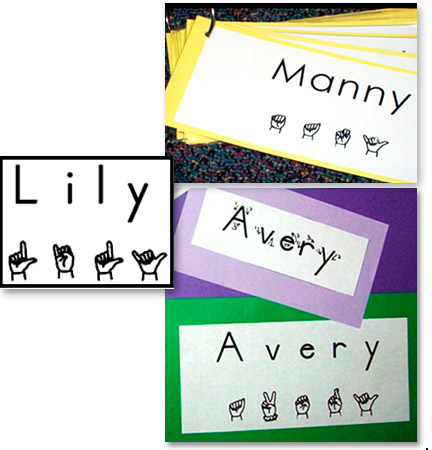
2. What font do you use to get the arrows on the child’s name ticket? I handwrite them in because the only ones we have found online use 3-lined paper. It hinders young children’s handwriting and writing development if they are asked to painstakingly write between three lines before they actually have developed automatic and efficient control of letters and shapes.
3. How do I teach handwriting in 2nd grade if the children did not get handwriting instruction in kindergarten or in first grade? Efficient handwriting motions and pride in doing quality work should be firmly entrenched by 2nd grade so children’s primary focus can be on producing thoughtful writing pieces that meet rigorous Common Core Standards. That is why K-2 teachers and district literacy coaches need to design a consistent, coordinated approach to handwriting instruction. It is very difficult, time-consuming, and tedious for 1st or 2nd grade teachers to have to reteach movement patterns for efficient handwriting if the foundation has not been laid in kindergarten. Consider using our original blog article as a starting point to begin this important dialog and collaboration within your school community because if handwriting skills are not efficient, it interferes with the whole writing process! By the 2nd grade level, we would hope teachers could continue modeling good handwriting and showcasing student examples of what “quality handwriting” looks like. Students might be engaged weekly in copying over a poem they have memorized with their “best handwriting”, and recopying an occasional writing piece for final publications. Kindergartners and primary grade students all appreciate the motivation of book publishing to inspire their best handwriting efforts. Set the standard: We do quality work in this classroom!


4. When do you teach spacing between words? Right from the start of the kindergarten handwriting journey with the power sentence, “I love you.” We have the child verbalize as they write “I (space), love (space), you (period or exclamation mark.”). Frequent teacher modeling and reminders will be needed. Children soon learn that they are writing for readers, and the spaces allow everyone to more easily read their sentences. Here again, the teacher’s expectations become evident in the children’s writing. Notice the spaces between words in these examples of “secret” messages.
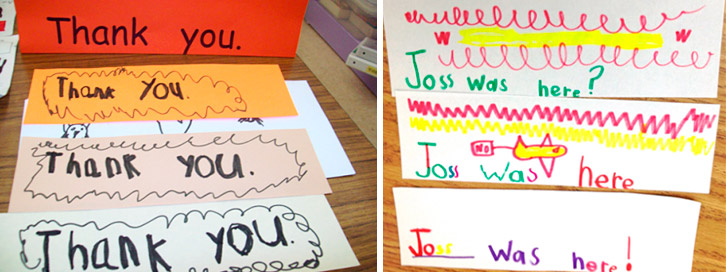
5. What do you think of the commercial handwriting programs? I have not personally used any commercial handwriting programs, however I am told that some programs start kindergartners working first on capital letters, which is a concern. We want kindergartners to be writing and reading lowercase letters right from the first days of school so we can build a classroom of prolific and engaged young writers who meet Common Core Standards by the end of the year. Our colleagues who have used commercial handwriting programs have indicated that the training programs and materials can be expensive and practicing individual letters on worksheets does not transfer to the writing process as well as opportunities to build whole word fluency. With limited 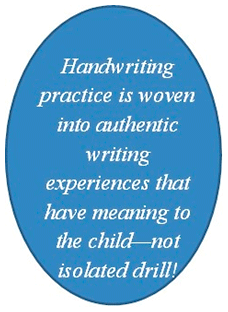 budgets, time restraints, and diverse kindergarten learners, we prefer approaches to handwriting that differentiate handwriting instruction while also teaching high-frequency “heart words” and reinforcing phonics skills. Our experience also has taught us that the counterclockwise “o” motion starting on a diagonal (as in “o, a, c, d, g”) is more easily generalized with fluid movement than starting the “o” at the center line as is taught in some programs. That said, “If your handwriting program works well for you, use it!” Consider weaving fingerspelling and handwriting practice with high-frequency words into your literacy framework. There is no one right way for every teacher to incorporate handwriting instruction into a day filled with meaning-centered learning. We developed our integrated approach to handwriting in collaboration with master kindergarten teachers; our goal was maximum fluency and transfer to the writing workshop in the minimum amount of time.
budgets, time restraints, and diverse kindergarten learners, we prefer approaches to handwriting that differentiate handwriting instruction while also teaching high-frequency “heart words” and reinforcing phonics skills. Our experience also has taught us that the counterclockwise “o” motion starting on a diagonal (as in “o, a, c, d, g”) is more easily generalized with fluid movement than starting the “o” at the center line as is taught in some programs. That said, “If your handwriting program works well for you, use it!” Consider weaving fingerspelling and handwriting practice with high-frequency words into your literacy framework. There is no one right way for every teacher to incorporate handwriting instruction into a day filled with meaning-centered learning. We developed our integrated approach to handwriting in collaboration with master kindergarten teachers; our goal was maximum fluency and transfer to the writing workshop in the minimum amount of time.
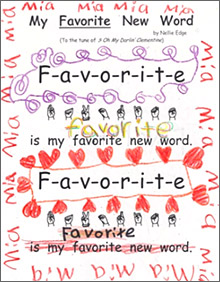
To summarize our priorities for kindergarten handwriting:
- Teach lowercase letters right from the start: begin with the child’s first name.
- Weave capital letter practices into authentic writing experiences. See article, How Do We Teach Capital Letters?
- Use multisensory memory hooks to accelerate the handwriting development.
- Avoid a one-size-fits-all, isolated skills approach.
- Teach o, a, c, d, and g as continuous motion letters.
- Do not waste limited budgets on consumable materials.
- Teach for immediate transfer to writing workshop.
6. Why do you recommend teaching ball and stick rather than D’Nealian? The vertical manuscript alphabet is more quickly mastered by young children. It is easier for them to learn to read, write, and spell using the same visual alphabet.
7. How do you work with the left-handed student? There are some excellent resource links for working with the left-handed learner on our Nellie Edge Pinterest Handwriting board. Also see article from our teacher’s guide called, How to Work with Left-handed Writers. It is important to be aware and sensitive to the unique challenges for the left-handed child learning handwriting. For example, when we provide large muscle patterning, the left-handed child grasps both hands together to perform the movements.
There are some excellent resource links for working with the left-handed learner on our Nellie Edge Pinterest Handwriting board. Also see article from our teacher’s guide called, How to Work with Left-handed Writers. It is important to be aware and sensitive to the unique challenges for the left-handed child learning handwriting. For example, when we provide large muscle patterning, the left-handed child grasps both hands together to perform the movements.
8. How does the Sing, Sign, Spell, and Read! program fit in 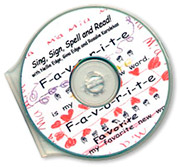 with handwriting? The “O” Dance and our handwriting songs and chants for 32 high-frequency “heart words” are recorded on this CD and accompanying anthology collection. Music, sign language, movement, and dance provide a multisensory and memorable link between high-frequency words, phonics, and handwriting. It simply multiplies our teaching effectiveness! Purchase NEW Music CD and
with handwriting? The “O” Dance and our handwriting songs and chants for 32 high-frequency “heart words” are recorded on this CD and accompanying anthology collection. Music, sign language, movement, and dance provide a multisensory and memorable link between high-frequency words, phonics, and handwriting. It simply multiplies our teaching effectiveness! Purchase NEW Music CD and
32 printed pages from our online bookstore.
9. When do you actually start using the handwriting books? The Kindergarten-Friendly Handwriting, Phonics, and Word Work writing and drawing books are designed to reinforce handwriting patterns that have already been introduced and rehearsed using “heart words”. We want most children to already have internalized basic handwriting motions before presenting them with these invitations to demonstrate handwriting using real words and sentences. Some teachers start these books in November while others (depending on the level of the writing progress) wait until as late as January. These pages provide an opportunity to target instruction (with small groups) to children who have been harder-to-accelerate while providing meaningful cognitive challenges for all learners. (Again, first see our blog article about how we teach efficient handwriting motions from the beginning of the year.)

10. What is your recommendation for eliminating the “b” and “d” confusion? Good first-teaching research from the Reading Recovery™ folks informed our approach to teaching “b” and “d” … First we intentionally teach “d” using the language “curve up and around, way up and down” with the words “dog” and “Dad”. Children learn to draw a dog and build fluency with power sentence patters: “I love my Dad.” “I see the dog.” Later we consistently teach “b” using a different beginning language and movement pattern “down, up and around.” Children write t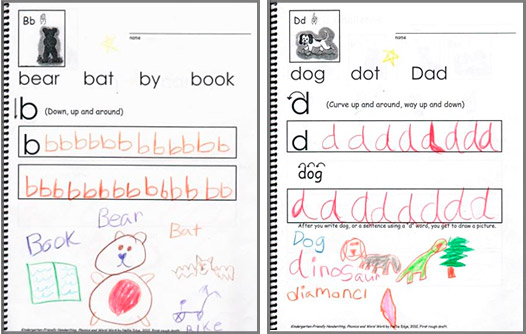 he words “book”, “by”, and “bat”. It is essential that children verbalize the directional language cues which immediately cue the brain differently. If one letter is woven into authentic literacy experiences for a week of writing (and drawing) projects before the other is introduced, children should avoid “b” and “d” confusion. Teaching both of the letters “b” and “d” with the same initial downward movement pattern is what creates the confusion for less experienced learners.
he words “book”, “by”, and “bat”. It is essential that children verbalize the directional language cues which immediately cue the brain differently. If one letter is woven into authentic literacy experiences for a week of writing (and drawing) projects before the other is introduced, children should avoid “b” and “d” confusion. Teaching both of the letters “b” and “d” with the same initial downward movement pattern is what creates the confusion for less experienced learners.
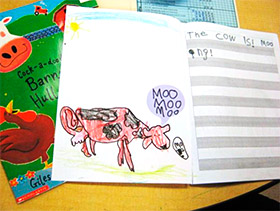 11. I notice you often don’t use lines. What kind of paper do you recommend? When do you use three-lined paper? Does it matter? Here again, K-1 teams need to decide on a consistent progression and there is no “just one right way” for every child. My colleagues often begin the year with drawing lessons and labeling on unlined paper. Within a month we use “kid writing” paper with a white space for children to use and a shaded space for adult underwriting. By mid-year most children no longer need adult underwriting and we use single-lined paper. In May, some teachers invite children to experience the traditional (first grade) “three lined paper!” During the beginning of the year, however, until children are more proficient, we want our young writers putting their energy into learning good handwriting motions and getting their ideas down in print rather than consuming so much energy focusing on how to navigate three lined paper. Cognitive overload slows down the learning process.
11. I notice you often don’t use lines. What kind of paper do you recommend? When do you use three-lined paper? Does it matter? Here again, K-1 teams need to decide on a consistent progression and there is no “just one right way” for every child. My colleagues often begin the year with drawing lessons and labeling on unlined paper. Within a month we use “kid writing” paper with a white space for children to use and a shaded space for adult underwriting. By mid-year most children no longer need adult underwriting and we use single-lined paper. In May, some teachers invite children to experience the traditional (first grade) “three lined paper!” During the beginning of the year, however, until children are more proficient, we want our young writers putting their energy into learning good handwriting motions and getting their ideas down in print rather than consuming so much energy focusing on how to navigate three lined paper. Cognitive overload slows down the learning process.
12. How do you help children who come into kindergarten without the fine motor skills to hold a pencil? This is a constant challenge in our large, diverse kindergarten classrooms, especially in half day programs, when teachers are feeling tremendous time pressure. I have heard (I do not have research or statistics) of preschools programs where teachers are wisely suggesting that developmentally younger children enter kindergarten a year later. Some researchers are recommending that boys start kindergarten at age five and a half since often their fine-motor skills are delayed that much behind girls. Once our states are funding a quality kindergarten model, we hope to see a more integrated approach to early literacy (preK-1) with options for some children to have an extra year in a strong developmental preschool or kindergarten which emphasizes language development, self-regulation, and small muscle skills.
There are currently pilot projects supported by National Institute of Child Health and Human 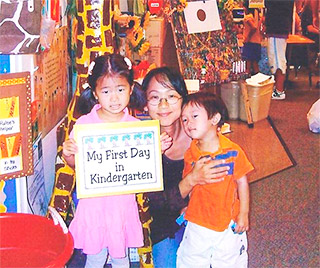 Development where they are targeting afterschool programs with kindergarten and first graders involved in skills to develop executive functions such as following directions and visual-motor skills such as cutting paper. We have attempted, as much as possible, to integrate both of these skills into our approach to handwriting, word work, and phonics. Children need time and opportunity to cut and paste, build with Legos, create models with clay, and copy drawing models.
Development where they are targeting afterschool programs with kindergarten and first graders involved in skills to develop executive functions such as following directions and visual-motor skills such as cutting paper. We have attempted, as much as possible, to integrate both of these skills into our approach to handwriting, word work, and phonics. Children need time and opportunity to cut and paste, build with Legos, create models with clay, and copy drawing models.
Fingerspelling is the best multisensory tool we know of to develop both finger muscles and ABC/Phonics memory connections in young children. We are happy to see more preschool and Headstart teachers using it. See the ABC Phonics tab at nellieedge.com for more details about this proven approach to accelerated literacy.
See article, Activities for Developing Fine Motor Coordination.
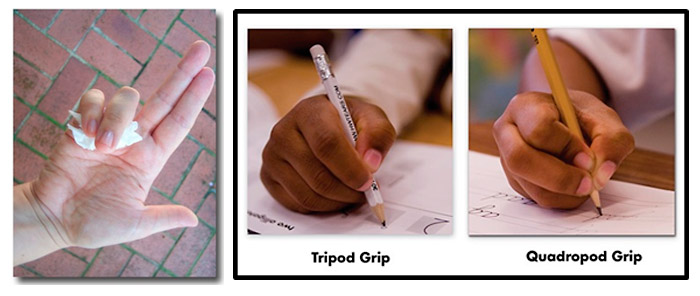
13. What do you tell parents about teaching handwriting in kindergarten? Parents are Partners in every aspect of building strong literacy foundations. This includes handwriting: We provide name-writing models and ask parents to help their child in daily name writing practice at home on specially designed Name Ticket Books. We send home skinny books (and other blank books) for children to engage in meaningful word work using high-frequency “heart words”. There are several sample parent information letters included in our handwriting teachers’ guide. We find parents are very pleased that we care about building good handwriting skills and are very supportive of our efforts. See Name Ticket Practice Book.

14. How is your kindergarten-friendly approach to handwriting different than traditional handwriting programs? Kindergarten-friendly handwriting is integrated with phonics and high-frequency word work (rather than primarily being taught as isolated drill). It is multisensory and includes fingerspelling and experiences in the arts. This approach does not require buying consumable workbooks each year; nor does this require the services of occupational therapists. (Though we wish all schools had one!) Our approach has a strong “Parents as Partners” component and has proven successful in meeting the accelerated writing standards of the Common Core. Traditional handwriting programs appear to progress slower, and be more expensive and time consuming to implement. The handwriting skills of older, traditional programs often do not introduce letters within the context of real words, so the transfer to actual “kid writing” is not as strong. Our focus from the start is on developing proficient writers. This begins with highly differentiated instruction where each child learns how to print their first name.
15. What handwriting apps do you recommend for the iPad? .
“Zaner-Bloser Handwriting ABC” ($1.99) and the free app called “Little Writer” are the ones my colleague Winter Curry recommends. We caution you against apps that have children tracing over all uppercase letters to create words.

16. What’s the easiest way to learn fingerspelling? Our publisher, Sign2Me, has generously provided quality instructional You-Tube videos to accompany our ABC Phonics: Sign, Sign, and Read! book and CD. You can access them from the ABC Phonics tab on our website. One of the excellent video tutorials teaches fingerspelling. Consider using it in the classroom and learn right along with your children!
Teacher expectations are huge in teaching all new skills—especially handwriting! Children KNOW if teachers expect them to to do quality handwriting or if sloppy work is acceptable. They will rise to meet the expectation of a knowledgeable, caring teacher. Kindergarten handwriting instruction is so much more than teaching efficient movement patterns for letters. We pay special attention to how we talk to and encourage children because handwriting is where we first have the opportunity to develop the children’s focus, metacognition, self-evaluation skills, and to develop their pride in doing quality work. Our approach to teaching handwriting aims to integrate foundational literacy skills while developing “habits of mind” that will support children in school—and in life!
For additional information see our Kindergarten-Friendly Handwriting Pinterest Board
Kindergarten-Friendly Handwriting, Phonics, and Word Work is available online. It includes a detailed teacher’s guide, beginning of the year group lesson templates, black-line masters for student writing books, and a sample bound student book.





